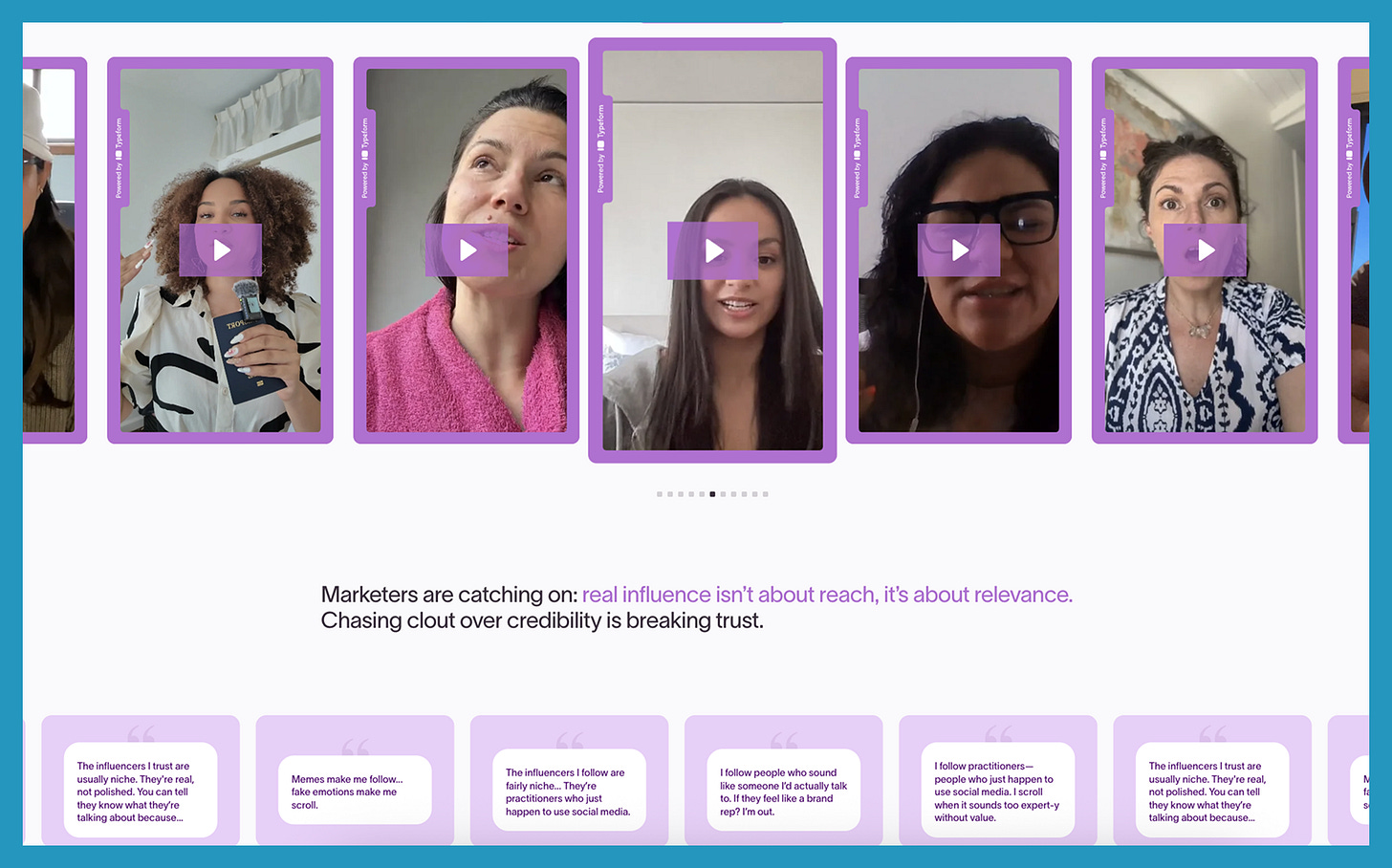Typeform collected 146 video responses for their 'Get Real' survey (and the result is one of the most engaging original research reports I've seen)
Should our content goal now be to centre authentic human connection in the age of AI-generated everything?
Hey friends,
This month I’ve kept returning to the same theme of authenticity.
AI tools can now spit out generic content in record time, which means content marketers are going back to the drawing board – thinking creatively about how to centre the most human aspects of what we do. Authenticity and real human stories are a big part of that conversation. But how do you truly create genuine authentic connections when the reality is that you’re doing it for marketing purposes – it’s always going to have a big element of the performative. A little insight into the inner workings of my mind this month.
This month's content example from Typeform explores exactly that challenge – plus it’s also the central theme of Nathan Fielder’s The Rehearsal, which I finished this month. More on that particular mind-bender, and how I think it might connect to content, below.
Let’s dive in.
This Month in Content Examples: Typeform's 'Get Real' influencer marketing research
What they did:
Original research reports are one of my favourite formats for B2B content marketing – using proprietary data from your product or conducting a survey to find unique insights on the problems your audience is wrestling with.
The classic approach is to turn those insights into a downloadable PDF (I’m guilty of this myself with our latest Ravio report).
This can be a good fit for some audiences, but the risk is that the user flicks through the PDF once and then it disappears into their download folder, never to be seen again, no matter how good the insights.
Typeform's 'Get Real' campaign takes a different approach. They surveyed 1,300 influencers, marketers, and content consumers about the reality of influencer marketing – what actually works, what feels fake, and where the industry's biggest challenges lie.
But instead of hiding insights behind a gated PDF, they created an interactive landing page that presents the key themes across five 'chapters’ centred around key quotes from the survey respondents.
The most interesting aspect to me is that they gathered 146 video responses as part of the survey, meaning they’ve been able to weave that video throughout the landing page (and use it for the wider campaign – that’s an instant 146 LinkedIn posts right there).
This, plus the heavy use of quotes throughout the landing page too, ensures that human voices are front and centre – it isn’t just showing the data findings, it’s highlighting the stories and evidence behind the data too.
Why it works:
There are lots of things to love in this campaign, but here’s a few of the elements that stood out to me:
1. Real voices, not just data points. Instead of sterile charts and graphs, you're hearing directly from the survey respondents with videos and quotes peppered throughout the landing page. Chapter titles like "Let the influencer cook" come straight from respondent quotes, making the insights feel authentic rather than manufactured. The LinkedIn campaign also focused on working with both respondents and other creators, again centring human experiences.
2. Interactive storytelling over static report. Rather than hiding insights behind a form, Typeform made the findings easily digestible and shareable. Each chapter includes actionable takeaways for marketers, influencers, and consumers right there on the page – turning research into genuinely useful guidance that users can come back to again and again.
3. Natural distribution built in. Distribution is often the hardest part of an original research report – you’ve got some great findings, but how are you getting people talking about them? By asking 146 people to submit video responses, Typeform essentially created 146 potential brand advocates who would naturally want to share their thoughts when the report launched.
4. Tapping into industry frustration. The findings on over-briefing and micromanaging creators clearly struck a nerve. The campaign sparked loads of organic conversation on LinkedIn, with creators and marketers sharing their own experiences around creative control and authentic partnerships – like Devin Bramhall, Isabelle Hasslund, and Christina Le, for instance.
5. Brand and product all-in-one campaign. Original research via surveys is perfectly aligned with Typeform’s product. The example of showcasing video responses also brings a beautifully subtle way to highlight Typeform’s own survey capabilities, with the option to gather video and audio responses built into their survey tool. It’s a brand campaign, but it’s a product campaign at the same time.
The result? A campaign that moves industry conversations forward whilst also showcasing Typeform's survey capabilities.
Need more inspiration? Head to the full library of examples.1. Typeform's actual findings from the 'Get Real' research example
It’s our content example this month, but the findings from Typeform’s research are also relevant for B2B content marketers too – I know I’m personally more and more looking at how we partner with influencers for expert insights and distribution opportunities at Ravio.
The key insight? Fake, scripted partnerships immediately turn consumers off. They want authentic influencers sharing real stories. Focus on finding credible voices in your space (not necessarily the biggest followings), listen to their actual stories, then give them creative control rather than dictating every detail.
2. Eli Schwartz's take on GEO being the new SEO
This month's hot topic is, of course, AI search optimisation (or whatever term we end up landing on) – it’s all over my LinkedIn feed and in basically every content newsletter I subscribe too. Including Eli Schwartz's 'Future of SEO' newsletter
His take is that with AI engines answering basic informational queries directly, top-of-funnel content for SEO purposes is becoming less and less effective. Instead, the new battleground is mid-funnel content – those users who know what category of solution they need but haven't chosen specifics. Think comparison guides, case studies, and solution-focused content that could get your brand mentioned in AI responses.
3. James Allen's data on how to get cited by AI
Another AI search optimisation one: James Allen's research for Search Engine Land explored the top sources that AI search engines are pulling from.
It turns out there’s quite a lot of difference – ChatGPT loves Wikipedia and authority sources, Google's AI embraces Reddit and community content, whilst Perplexity favours expert review sites.
But, the main theme is that being present in community forums, industry publications, and third-party review content might matter more than your own company blog for AI citations.
4. Beam Content's approach to product-led content without the sales pitch
This month Beam Content published an article on ‘How to create product-led content without sounding like sales’. It’s packed full of interesting insights from product marketers, but the most interesting point to me was the importance of continuing to centre the customer and their problems even in bottom-of-funnel, product-led content.
As Growth and Product Marketing Advisor Nicole Silver puts it: "I've always taken the perspective that the customer is the hero, not the product." Instead of creating content that aims to show what your product can do, start with the pains that your audience are feeling, and weave the product naturally into that.
I also thought that Sam Brenner's observation that "Your audience's eyes glaze over when they see CTAs. They're thinking, 'Oh, this company is always putting their trash in the CTA box, but the advice is good. Just ignore the product.'" was an astute one. When we do talk about the problems our product solves, we’re tempted to add a ‘book a demo to see how we’ve fixed this’ style CTA. But we should just be showing there and then exactly how our product addresses that particular problem, in a way that showcases the real value of the product – interactive demos or sandbox environments, rather than hiding everything behind "book a demo" walls that create barriers instead of building trust.
5. Emily Kramer's 'shows vs feeds' framework for company blogs
Recently Emily Kramer's MKT1 newsletter explored the question of ‘is the company blog dead’. It’s an interesting question that very much depends on the context of the company and their content aims.
One idea I thought was worth bookmarking was switching from creating "feeds" (random streams of forgettable blogs), to "shows" – intentional, episodic content where each piece builds on the last to create a full series. These recurring themes and formats could be a great way to build deeper audience connections with the content being produced.
Looking for more insights and advice on how to approach content for your company? Go to the full swipe file.I’m late to the party, but this month I finally finished Nathan Fielder's The Rehearsal – both series 1 and 2.
The basic concept: giving people the chance to rehearse anxiety-inducing life situations in meticulously recreated environments before facing them in reality.
What makes it compelling is the sheer commitment to the premise – building exact replicas of bars and airports, lengthy tangents like putting on an entire singing competition TV show just to make one part of one episode possible (which also raised a lot of ethical questions with participants feeling manipulated), creating "rehearsals for rehearsals" until the line between preparation and reality completely dissolves.
This overarching theme of the paradox of ‘performing authenticity’ is, I think, relevant for content marketers too.
The content marketing lesson? Just like Nathan obsessively rehearsing every detail to achieve "authenticity," brands can get so focused on manufacturing genuine moments that they lose the very humanity they're trying to capture.
As AI-generated content floods our feeds, consumers are craving real human connection more than ever. Typeform's research this month shows exactly that – when partnerships feel scripted or fake, people immediately switch off.
In marketing it’s very difficult to keep that authentic human connection, because the moment you're trying to be authentic for marketing purposes, you've already lost authenticity.
To me, it’s all about what happens before the content even gets created.
At Ravio, our most genuine content comes from working with our Chief People Officer Vaso to share her real struggles with compensation throughout her career, or collaborating with partners who genuinely want to share their experiences. In all of those cases, the relationship comes first – the connection happens over the shared experiences and problems. The content is just a natural byproduct, and we’re able to centre the real stories gathered.
That's a wrap for July!
What content has caught your attention this month? Hit reply and let me know – I'm perpetually adding to my swipe file and I’d love to hear what you’re adding to yours.
Speak soon, Tabitha
P.S. If you found this useful, please share it with a fellow content marketer. Word of mouth is how we grow this little community 🫶.












